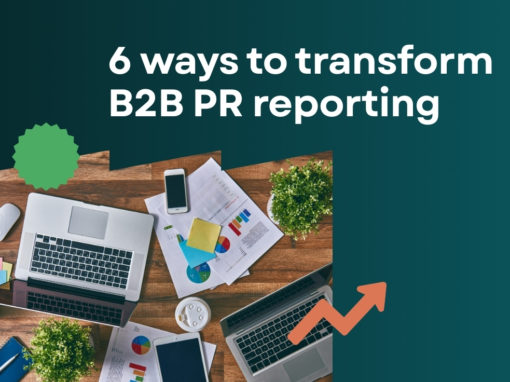When did you last screenshot a LinkedIn post and send it via WhatsApp to one of your colleagues or friends?
I did it just a few minutes before I started working on this blog post. It was a post about how someone fixed a GA4 attribution issue, if you’re interested!
Anyway, the reason I ask is because the sharing of online content through private, untrackable channels, otherwise known as dark social, is pretty much embedded into our everyday lives.
In fact, multiple studies have revealed that between 80 and 95% of all online content sharing is now attributed to dark social – and media coverage is no exception.
A huge proportion of your PR efforts are gaining traction where you can’t see them.
What type of content is being shared via dark social?
Links and screenshots of news stories, websites, blog posts, videos and products all feature heavily in the types of content being shared in private messaging apps. Much of this content represents the bread and butter of the PR industry. In many cases, users are discovering news stories on open social platforms and are then pulling them into private networks where unfiltered feedback and/or commentary can be discussed without fear of being judged.
Sharing news stories privately, or via dark social, still amplifies reach and influence in several ways though.
- Increased trust and credibility: When friends or colleagues share curated stories with one another in a safe, private environment, the impact is greater because the recommendation comes from a trusted source, making the content more influential and consequential than if it were encountered through ads or an open public feed.
- Unfiltered feedback and commentary: Private networks allow for discussions without fear of being judged. Users can share unfiltered feedback and commentary, which can deepen engagement with the content and lead to way more meaningful conversations.
- Strengthened relationships: The intimacy of dark social helps to strengthen relationships as it’s a more personal interaction, helping to foster a sense of connection and shared interest.
- Higher engagement = more intentional action: Dark social drives engagement, which in turn leads to action. Big increases in direct web traffic and unexplained spikes in engagement are often the result of dark social sharing, indicating that private sharing can effectively motivate users to take further steps, such as visiting a website.
Why is dark social use so prolific?
There are two primary drivers responsible for the continued use of dark social and it’s worth noting that we don’t expect either to ease anytime soon.
Privacy concerns: Over the past few years, there’s been growing public concern about how personal information is exploited by social media companies. Many of us know that, by posting content to open social channels, we’re essentially allowing our data to be exploited for commercial gain.
However, private messaging apps have traditionally offered more privacy as platforms like WhatsApp, Signal and Telegram, encrypt messages. Advertisers aren’t given access to the contents of the messages. Here, trust is vital and mistakes are punished.
I’m sure you remember the mass exodus from WhatsApp to Signal a few years ago after WhatsApp announced users had to accept new terms requiring data sharing with Facebook.
Just in case your memory is hazy, WhatsApp did reaffirm its commitment to user privacy and emphasised that the updates didn’t affect the privacy of personal messages, which continue to be secured with end-to-end encryption, meaning neither WhatsApp nor Facebook can read users’ private chats (thank goodness!).
Impact on mental health: It’s no secret that social media usage causes stress and anxiety, particularly among younger users. In fact, 45% of Gen Z respondents feel there’s ‘too much pressure to be perfect’ on social media, research from GWI revealed. It’s easy to understand why many prefer the intimacy of dark social media as they’re away from the prying eyes and often harsh judgment of the broader public.
Can you measure the impact of dark social in PR?
Now if I had a pound, or euro, or dollar (you get the point!) for every time I was asked if dark social use in PR could be measured, I’d be rich. The short answer is kind of. The long answer is that dark social activity in PR can be estimated (and it absolutely should be as it helps to better show the value of PR).
Firstly, using Google Analytics to look at your website traffic can help. Big increases in direct web traffic and unexplained spikes in engagement are often the result of dark social sharing.Yes, really. And that’s because dark social drives engagement, which, in turn, leads to action. Don’t forget AMEC’s Barcelona Principles, which at the very core, encourages us communicators to focus on business outcomes and impacts.
Another way to estimate the impact of dark social is to consider the Releasd PR reporting platform. It has a proprietary algorithm based on analysis of open social sharing data combined with third-party sources like GetSocial, that specialises in tracking dark social activity to estimate the number of shares and views an article receives on platforms associated with dark social.
How does it work?
Releasd’s dark social measurement method estimates the number of shares and views an article receives on so-called dark social platforms (such as WhatsApp, Facebook Messenger) based on patterns observed in open social sharing.
Do you need to know the open social activity to estimate the use of dark social?
Yep. It relies on the correlation between known open social activity and the likely dark social engagement to produce estimates. If there’s no open social activity for a piece of content, dark social shares are estimated as zero.
Where does Releasd get its data from?
Releasd partners with data providers like SimilarWeb to analyse website visits and combine this with open social metrics for a fuller picture. The total of a story’s views across open and dark social is called “Coverage Impressions” within the platform.
PR pros must highlight the hidden reach of their coverage within private sharing channels. By estimating the influence of dark social, they can tackle one of the toughest challenges in measuring modern PR success.
Want to see how Releasd’s PR reporting platform can help you measure the impact of dark social? Book a demo here.



